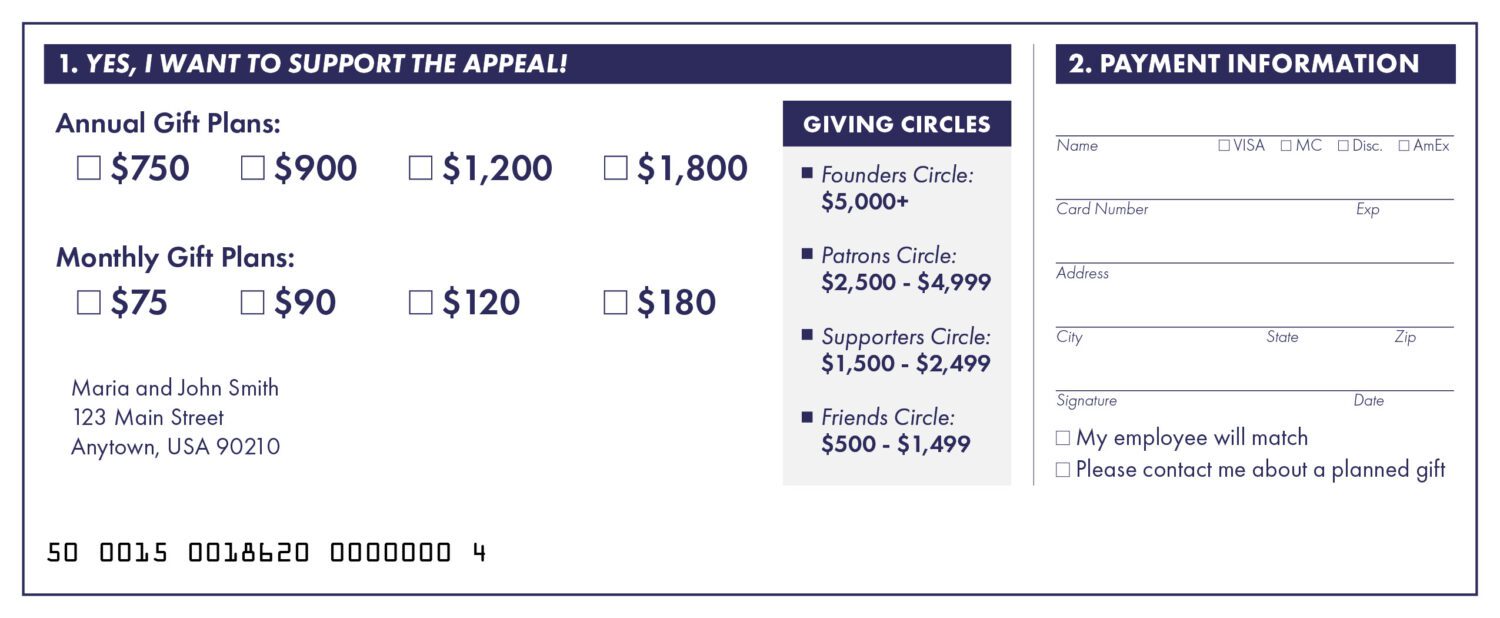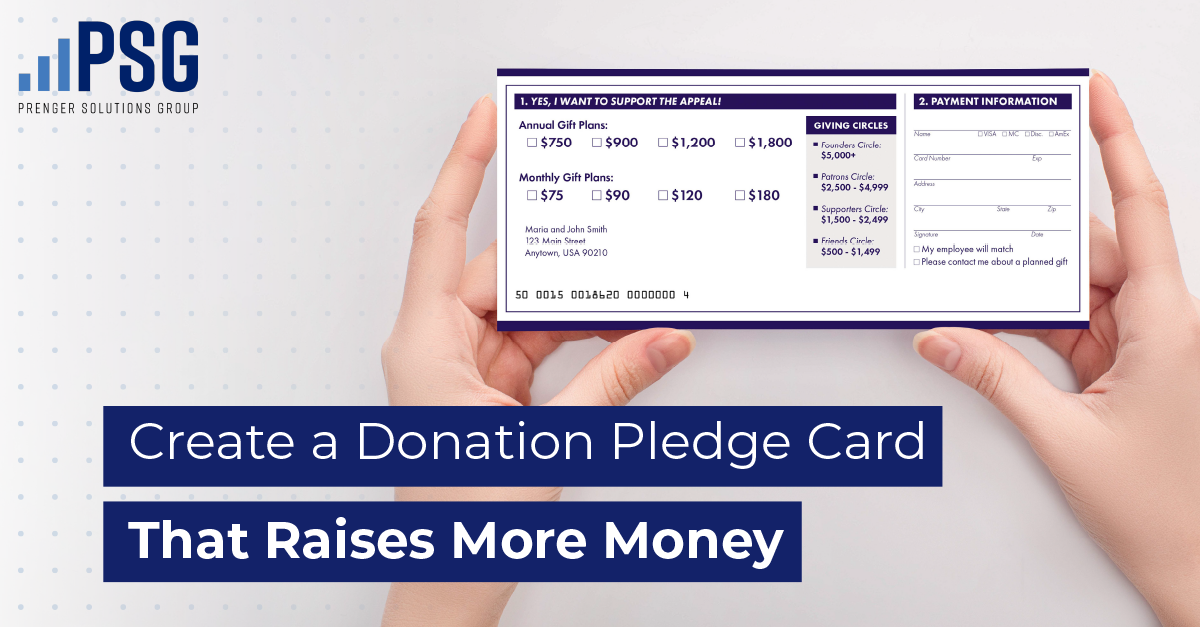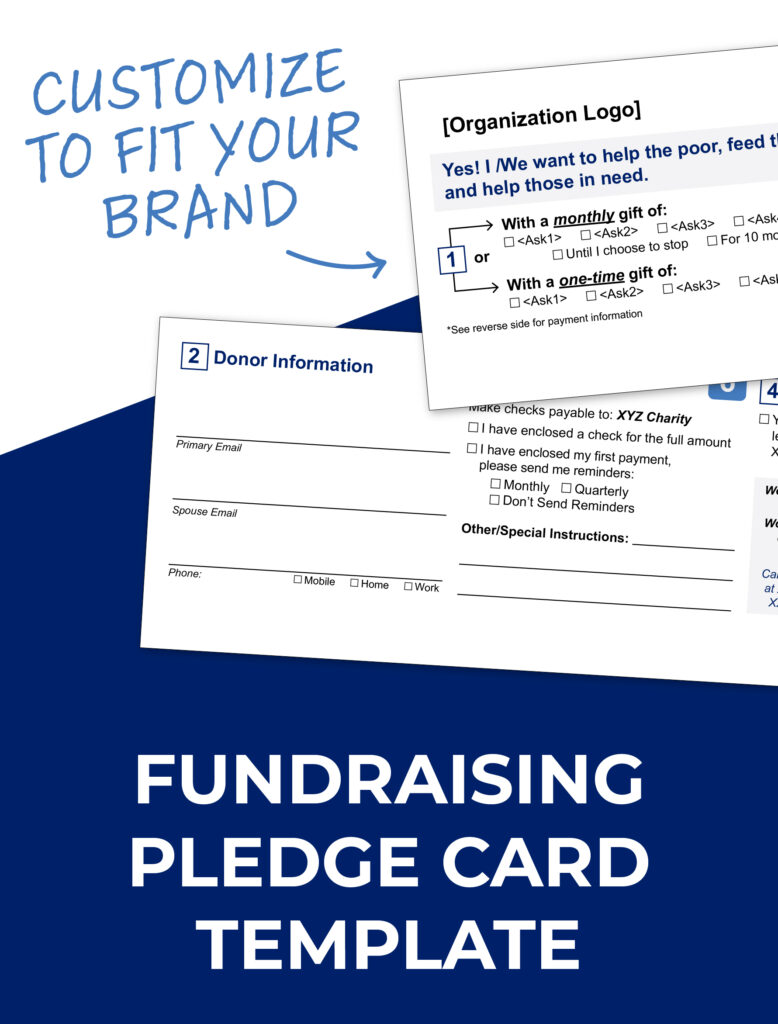If you’re like most nonprofits, you have a fundraising pledge card template. You’ve been using it for years, and it includes a series of ask amounts (sometimes called a gift string, gift array, giving ladder, ask array, or ask ladder). Today, we’re discussing how to ask for a suggested donation on your next pledge card.
It’s a tried-and-true method that has been proven to increase direct mail fundraising response rates compared to an open-ended form that asks the donor to come up with an amount on their own.
But here is the million-dollar question: Do you put the ask amount numbers in order from low to high, or from high to low?
Based on decades of direct mail fundraising for nonprofits, our recommendation is to present your ask strings in ascending order (the numbers start small, then get higher as you read left to right).
Your campaign pledge card should be in ascending order
When reaching out to your targeted audience: new donors, potential donors, or donors who have lapsed (inactive for a set number of months or years), the goal is to ease these people into giving.
If you’re inviting a former donor to give again, you’ll want to create an appeal using soft, emotional, and inspiring language. Your ask string should mirror that approach, starting at a comfortable level that allows the donor to ease back into the habit of contributing to your organization.
The same principle applies when soliciting new donors. While every fundraising campaign has heard stories about a stranger who suddenly appears and writes a million-dollar check to your organization – the reality is quite different. Donors don’t just come out of nowhere with giant gifts – they start small and increase their giving based on their donation experience and view of the organization.
By ordering your ask string in a way that starts with a reasonable amount and then increases the request as the donor continues to read the card, you’re more likely to get a first-time donation to your appeal.
Avoid displaying ask strings in descending order
Fundraising is all about making your donors feel loved and appreciated. Your goal is to ensure that each donor knows their gift is important and valued, no matter the amount.
That message of appreciation gets muddled if you send your donors a pledge card, and the first ask amount they see would require them to double or even triple their current giving level.
Use this pledge card example: a donor who has supported your organization with an annual gift of $750. The donor believes deeply in your cause and is excited to give again. Then, she receives your direct mail fundraising letter and goes to fill out the reply card where you’ve put the request amounts in descending order. Suddenly, the donor’s gift doesn’t feel so great anymore.
To the donor, her previous gift level appears to be the lowest possible gift on your string:
- $1,800.00
- $1,200.00
- $900.00
- $750.00
If she makes that $750 gift again, she’ll feel she’s only doing the bare minimum. She’ll feel like a cheapskate. This not only provides a poor experience for your donor, but it also actually improves the chances they don’t give at all.
She reads through your suggested amounts, and as she does, she thinks:
- “$1,800 – whoa, that’s a lot of money – way more than I normally give.”
- “$1,200 – that’s still a lot. What the heck?”
- “$900 – where’s the amount I normally give?”
- “$750 – okay, there it is. But wait, why is this the last option?”
Then, she feels indignant because you’re making her feel cheap. And because you’re asking her to give five times more this year than last! Don’t you know who she is? Why are you being so greedy? It is important to note that there is a specific number of ask amounts you should include on your pledge card.
We see this scenario play out time and time again. But there is a better way.
Present the perfect ask string with suggested donation amounts
Backed by human psychology, our fundraising strategies, and research studies on creating the perfect nonprofit pledge cards for fundraising… present the ask string in ascending order.
That same donor, who gave $750 last year, will have a much different experience as she reads the ask string from left to right:
- “$750 – yep, that’s what I usually give; I’ll probably check this box, but let me check and see what the next level up would
 feel like.”
feel like.”
- “$900 – yeah, I could probably do that.”
- $1,200 – you know, I’ve had a really good year, and I love this organization, so maybe I’ll step up this year and do this.”
- “$1,800 – nope, that’s way too high for me right now. Let’s go back to $1,200 or $900.”
There is a night and day difference between the two giving experiences. In the first, the donor feels irritated, undervalued, and indignant. In the second, the donor feels appreciated and GENEROUS when she decides to increase her gift.
Setting personalized ask strings doesn’t have to be complicated; use AskGenius to help customize the right ask amount for every donor.
Don’t just take it from us
In Tom Ahern’s book, If Only You’d Known…You Would Have Raised So Much More Money, the author writes about a test he conducted where “…the largest-to-smallest ask string raised 25 percent LESS. The largest-to-smallest gift array, in fact, was a two-time loser: not only were fewer gifts made, but the average gift was also smaller.”
Want to raise more money and improve your average response rate? Start presenting those asks in ascending order!
You will start to see the amount of gifts increasing through the power of customized ask strings. And for more insights like this delivered straight to your inbox, sign up for the Prenger Solutions Group newsletter today.
















